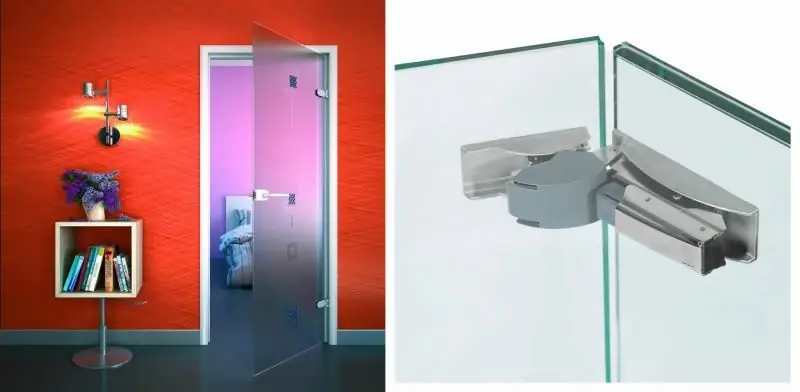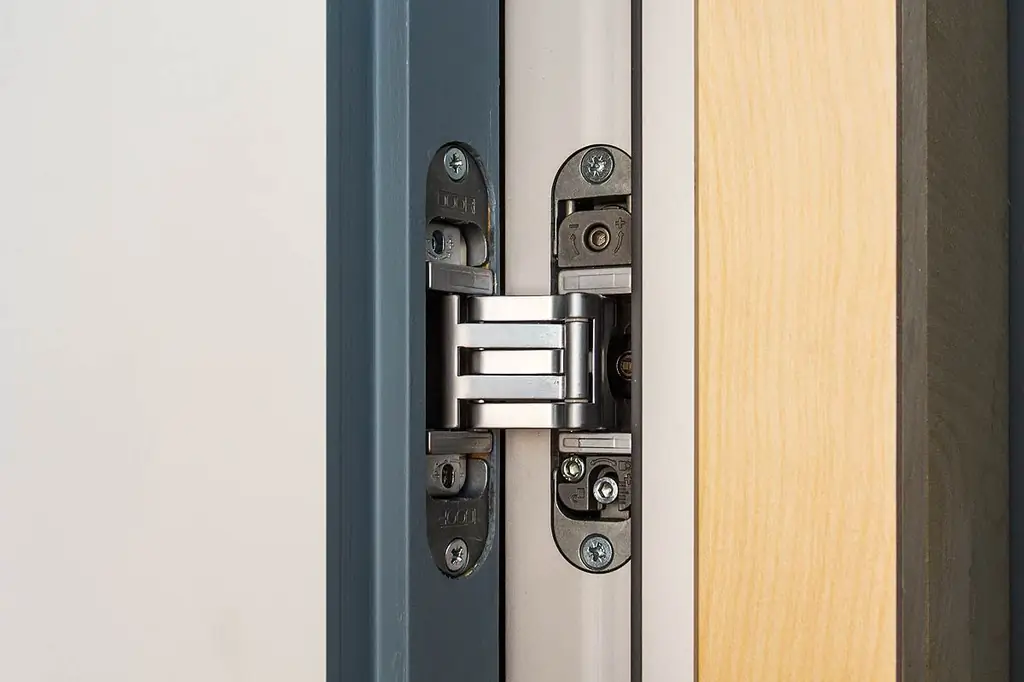
Table of contents:
- Author Bailey Albertson [email protected].
- Public 2023-12-17 12:53.
- Last modified 2025-06-01 07:32.
Butterfly hinges for interior doors

When choosing hinges for interior doors, it is necessary to understand their functional differences. Butterfly card hinges are easy to install and serve well. But only on condition that the technical operating conditions are observed.
Content
- 1 Description of the design of butterfly loops
-
2 Features of installing butterfly hinges for interior doors
2.1 Video: installation of butterfly loops
- 3 Reviews
Description of the design of butterfly loops
The butterfly hinge mechanism consists of a metal axis on which two plates (cards) rotate with holes for fixing to the door leaf and frame. The shape of the plates is such that when folded, the loop looks like one sheet (one card is inserted into another).

The shape of the loop in the open state resembles the wings of a butterfly
Bushings (bearings) are located between the plates, which provide free rotation around the axis. Metal thickness from 1.5 to 2.0 mm. This is enough to withstand a load of up to 50 kg (that is, the weight of an interior door). The hinges are non-separable and have two modifications:
- butterfly hinges for doors without rebate;
-
butterfly hinges for rebated doors (with an additional bend).

Butterfly hinge for rebated doors Additional bending of the plates allows you to fully open the rebated door
The materials for manufacturing are:
- brass (alloys with golden and bronze shades);
- stainless steel;
- Cink Steel.
Brass hinges cost less and look more massive due to the thickened plate size. The price of steel is higher, but the strength is much higher.
The color scheme of butterfly loops does not differ in variety. These are silver, gold, bronze and chrome shades. In addition, the outer coating of the plates is glossy or matte. There are also white painted hinges on sale.

Butterfly hinges are available in silver, gold, bronze and chrome shades
The main design difference of this type of hinge is its ease of installation. It is with the availability of installation that their popularity among craftsmen is associated. The fixing is done with ordinary screws, and no tapping is required. This significantly speeds up the door suspension procedure without compromising on quality.
The advantages of loops include:
- minimum installation tools;
- the design of the mechanism ensures long-term operation and does not require additional maintenance;
- lack of preparatory work before installation (sampling of grooves in wood);
- the gap between the curtain and the box is less than when installing conventional hinges (which improves sound and thermal insulation).
A number of disadvantages are also noted:
- cannot be used for hanging heavy (entrance) doors;
- when dismantling the door leaf, the hinges must be disconnected (unscrewed);
- the contact surface under the hinges must be completely flat.
From personal experience of installing butterfly hinges, I would like to add that neglecting the last item in the list of shortcomings often leads to a skewed door leaf. At first, this is a subtle displacement, rapidly progressing during operation. As a result, not only the canvas and locking fittings become unusable, but also the axis of the loop itself (especially the lower one) wears out unevenly. This ends with the fact that everything has to be changed, since the suspension cannot be restored and repaired.
Features of installing butterfly hinges for interior doors
Self-assembly does not require high qualifications or special skills. However, the matter must be approached with accuracy and pedantry. A slight misalignment during assembly is fraught with trouble in the future.
Tools and materials required to install the hinges:
- awl, marker;
-
wood drills of different diameters;

Wood drill set For work, a drill with the desired diameter is selected
- construction tape;
-
screwdriver.

Screwdriver Variable speed screwdriver for drilling holes and screwing in self-tapping screws
The sequence of work is as follows:
-
The markup is being done. The hinges are installed at a distance of 20-25 cm from the lower and upper corners of the sash. Sometimes craftsmen place the lower loop further from the edge (30-35 cm), since it is this that carries the main workload. The upper loop is mainly used to hold the web in an upright position.

Location of door hinges When marking from the top edge to the loop, lay 20-25 cm
- A butterfly loop is applied to the installation site and the places where the screws are screwed are marked with a marker or awl.
-
Holes are carefully drilled at the designated points. The drill diameter is selected in such a way that the section is 1 mm less than the screw diameter. The hole depth should be 3-5 mm less than the self-tapping screw length.

Setting the butterfly loop During drilling, the screwdriver must be at right angles to the end of the door
-
The hinge is fixed to the sash using screws. Pre-screw 2 screws into the extreme holes of the hinge. This is necessary so that the position of the mechanism can subsequently be adjusted.

Butterfly loop fixation In case of skewing, the screws are released and the position of the hinge is corrected
-
The canvas is inserted into the box, the places for the screws on the frame are marked. For convenience, the sash is deflected by 30-45 °, and a support is placed under the lower end.

Attaching the butterfly hinge to the frame When attaching the hinges to the frame, it is necessary to screw the screw completely into the seat
- Holes are drilled on the box. In this case, the same rules must be observed as for the holes in the canvas.
- Having previously checked the vertical position of the sash, the door is fixed. The screws are finally screwed in so that the caps are completely hidden in the thickness of the hinge.
Sometimes there are disputes among the masters about which side of the butterfly hinges should fall on the frame, and which on the canvas. Many people think that a large (outer) card should be screwed onto the box. Others take the opposite point of view. However, in reality, as shown by tests from manufacturers, there is no fundamental difference. The only thing that should be taken into account is the condition of the supporting surface and act according to the situation.
It is also useful to know that if the plane of the sash or box is not entirely flat, you have to resort to various tricks. Thick cardboard or plastic plates are used as linings. It is very important to install the hinges so that they fold completely when the doors are closed. Otherwise, the canvas will "spring", that is, it will not close completely.

To align the position of the loop, use thick cardboard or polymer geo-canvas
Video: installation of butterfly loops
Reviews
Butterfly hinges are ideal for lightweight interior doors. When installing massive door blocks made of natural wood, it is better to give preference to classic hinges with mortise grooves.
Recommended:
Glass Door Hinges: Varieties, Design Features, And How To Properly Install And Adjust

Types of hinges for glass doors: by type of construction, installation method and material of manufacture. Rules for fastening and adjusting loops
Hidden Door Hinges: Description, Advantages And Disadvantages, As Well As How To Install Correctly

Arrangement of conventional concealed hinges and models with built-in door closer. Advantages and disadvantages of hidden awnings. Features of their installation and adjustment
Overhead Door Hinges: Description, Advantages And Disadvantages, As Well As How To Install Correctly

Purpose, device and types of overhead door hinges. Pros and cons. Features of installing overhead hinges, depending on the material of the door
Door Hinges: Types And Characteristics, Pros And Cons, As Well As How To Install Correctly

Purpose of door hinges and their main types. Classification by material and type of construction. Features of mounting hinges on canvases made of different materials
Door Handles For Interior Doors: Varieties And Characteristics, Pros And Cons, And How To Install Correctly

How to choose the right handles for interior doors. Features of the handle design. Installing handles on different types of doors and DIY repair
